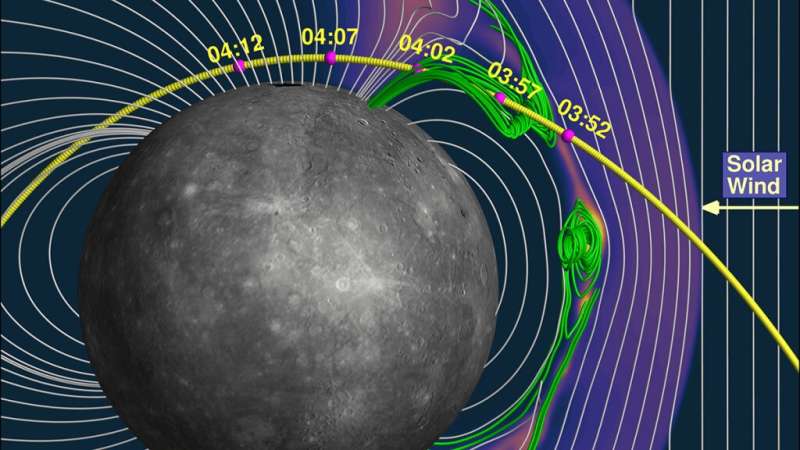Solar wind a major driver of atmospheric sodium at Mercury

No object in the solar system experiences the sun's solar wind more powerfully than Mercury. The planet's magnetic field deflects the sun's stream of electrically charged particles at a distance of only 1,000 kilometers from Mercury's surface, a point called the magnetopause.
The sun's magnetic field lines are carried by the solar wind and bend as they collide with those of Mercury. When conditions are right, these bent lines break and meet with those of Mercury in an event called magnetic reconnection. During reconnection, particles from the solar wind can penetrate Mercury's magnetic field. These particle transmissions are called flux transfer events (FTEs), and a burst of FTEs in rapid succession is known as an FTE shower.
In a study published in Journal of Geophysical Research: Space Physics, Sun et al. investigate the effect of these showers on the planet's surface using data collected by NASA's MESSENGER (Mercury Surface, Space Environment, Geochemistry, and Ranging) spacecraft, which orbited Mercury between 2011 and 2015. As the spacecraft passed through Mercury's magnetopause and toward the surface, the onboard ion mass spectrometer, FIPS (Fast Imaging Plasma Spectrometer), recorded the local abundances of sodium group ions, including sodium, magnesium, aluminum, and silicon ions. Simultaneously, an onboard magnetometer measured the local magnetic environment. During the course of MESSENGER's orbital mission, this scenario occurred 3,748 times, and half included the observation of an FTE shower.
The authors perform a statistical analysis of the abundance of sodium group ions in Mercury's atmosphere. During approaches coincident with an FTE shower, they find that the abundance of sodium group ions in the atmosphere is about 50% higher during non-FTE shower periods. After examining several potential mechanisms for this enhancement, the scientists conclude that sputtering from the solar wind is the most likely cause.
These MESSENGER observations are an important indicator of the dynamism of Mercury's thin atmosphere, according to the authors. In addition, more information is likely to come in early 2026 when the joint European-Japanese mission BepiColombo arrives at Mercury. The mission consists of two spacecraft, one targeted at Mercury and one targeted at its magnetosphere. Working in concert, they should provide unprecedented detail on FTE-induced solar wind sputtering.
More information: Weijie Sun et al, MESSENGER Observations of Planetary Ion Enhancements at Mercury's Northern Magnetospheric Cusp During Flux Transfer Event Showers, Journal of Geophysical Research: Space Physics (2022). DOI: 10.1029/2022JA030280
Provided by American Geophysical Union
This story is republished courtesy of Eos, hosted by the American Geophysical Union. Read the original story here.




















